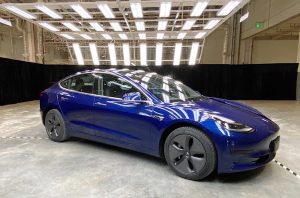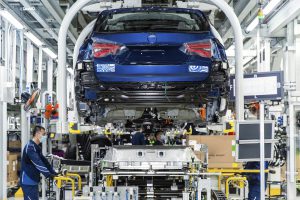Already the world’s largest market for plug-based vehicles, China now expects to see demand rise four-fold to 20% of new vehicle sales by 2025.
That goal, announced Monday by the powerful State Council, the Chinese cabinet, matches the forecast announced a week ago by the China Society of Automotive Engineers, or China-SAE. That said, it actually is a bit lower than the 25% target set last year by a Chinese ministry, noted Reuters.
Nonetheless, it should keep China on a path to remain the world’s largest market for electric vehicles through at least the middle of this decade. Longer term, the country’s Ministry of Industry and Information Technology set a target of reaching 50% by 2035.
(NEVs will be 20% of new vehicles bought in China by 2025.)
The country’s current New Energy Vehicle, or NEV, rules includes both plug-in hybrids, or PHEVs, and pure battery-electric vehicles, or BEVs, as well as a small number of hydrogen fuel-cell vehicles. But, by 2035, the China-SAE expects that all-electric models will account for 95% of vehicles qualifying for the NEV program.

Tesla’s Model 3 sedans built at the Shanghai Gigafactory were the top-selling EV in China until recently.
China has been taking a carrot-and-stick approach to promote demand for plug-based models. That has included cash incentives as well as waivers allowing NEV buyers to sidestep monthly restrictions set by many major cities – such as Beijing and Shanghai – on the number of new vehicles that can be registered.
In a policy paper that is part of China’s 14th five-year plan, government officials did not say why they trimmed back the NEV target from the 25% proposed by the industry ministry last year. But, after a strong burst of demand for electrified products in 2017 and 2018, demand started slipping in 2019 as incentives were cut back. Sales have yet to fully rebound, even as the overall Chinese market continues to recover from the impact of the COVID-19 pandemic.
Even at the lower rate, the numbers would be substantial. China was the first country to reach 1 million sales for plug-based vehicles, last year’s numbers coming to 1.2 million, or about 5% of the Chinese new vehicle market. Were overall sales just to stay flat through mid-decade, then, that would mean NEV sales of about 5 million, based on the EV sales predictions. And most forecasters anticipate the Chinese car market will fully rebound by then.
(China revising NEV production rules to help automakers.)
Meeting the government’s new NEV target won’t be easy. As with the U.S., the country’s automakers face a variety of challenges, including vehicle range, the lack of a widespread charging infrastructure, and price. But costs have begun coming down. In recent months, China’s best-selling battery car has been the Wuling Mini, a product of a three-way joint venture between General Motors and homegrown carmakers SAIC and Wuling. It starts at just 28,800 yuan, or about $4,200.

Wuling’s new Mini EV, which starts for about $4,200, is the new top seller in the electric vehicle segment.
One key difference between the two markets is the control the Chinese government exercises over product planning. And regulators are pressing hard to encourage the launch of new products. Many of the new NEV vehicles are coming from the dozens of startups entering the electrified space, both domestic and foreign owned. Tesla has become one of the segment’s powerhouse players since opening up a factory in Shanghai late last year.
Homegrown carmakers like BYD and Great Wall, meanwhile, see the NEV market as a way to take on more established manufacturers. According to Michael Dunne, founder of Asian consulting firm ZoZo Go, as many as 200 companies are seeking government permission to enter the EV market, though he told TheDetroitBureau.com that only a fraction are likely to win approval.
Nascent entries could find it easier – and more affordable – to get up and running if Foxconn has its way. The company, best known as the manufacturer of the Apple iPhone, recently announced that it has developed a skateboard-like EV platform that new EV makers could use to underpin their own vehicle designs. Foxconn would then assemble the products at a new factory it is setting up.
(GM finds plenty of Chinese buyers plugging in with new $4,200 EV.)
Chinese automakers are looking to find a market not only at home but abroad for their electrified products. The first of these to reach the U.S., the Polestar 2, went on sale barely a month ago. Polestar is a spinoff of Swedish automaker Volvo — which, in turn, is owned by China’s Geely. The all-electric model is assembled at a plant near Geely’s headquarters in Szechuan Province.
For GREAT deals on a new or used Toyota check out Right Toyota TODAY!
